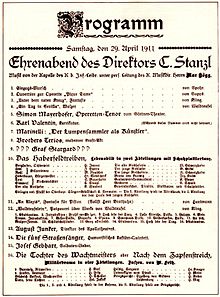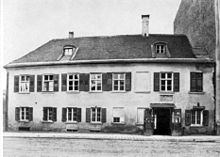Conny Stanzl
Conny Stanzl , actually Konstantin Pfrang or Constantin Pfrang , (* July 2, 1870 in Munich , † September 24, 1951 there ) was a German folk singer and humorist.
Life
Konstantin Pfrang was born as the son of the master carpenter Franz Pfrang and his wife Amalia, nee. Lammerer, born at Schillerstraße 17 in Munich. He attended elementary school and initially learned the gilding trade, but was active as a reciter and lieder singer for clubs at an early age. His uncle, the well-known "Waldschmidt", Hofrat Maximilian Schmidt , and the theater director Georg Lang (1839–1909) discovered his talent, but at the insistence of his mother, who did not want a "comedian" in the family, he had to be offered an offer from the gardener theater turn down for roles as a singing teenage lover and comedian. After the death of his mother, he immediately joined various societies. His first public stage appearance took place in 1889 with Josef Aigner in Krailling. Then he got an engagement with the singer Paula Sporrer, first to Stuttgart and then through all of Germany, Alsace-Lorraine, Switzerland and Austria. On the day of his return to Munich in 1906, he was hired by the Lipp-Amthor company for the Mathäser-Bräu. After five years he moved to Jakob Kirchner-Lang, but soon founded his own successful companies: Stanzl-Gebhart (with Josef Gebhart) and Stanzl-Schwarz (with Alois Schwarz). This troupe performed from Monday to Saturday in different locations in Munich. A prominent guest of his honorary evening on April 29, 1911 in the Café Perzel on Munich's Marienplatz, where Pfrang played successfully with Hans Blädel for many years, was Karl Valentin . In 1912 he was with Sigl-Stettmaier director of the "Münchner Sänger" (Hotel and Konzerthaus Fendt), and like Karl Valentin, he also appeared with Joseph Vallé in the Monachia.
As early as the 1920s, however, Munich's folk singers, comedians and singspiel companies were struggling with falling income. Above all, the increasingly popular cinema, competition from outside vaudeville groups and sporting events increasingly spoiled business. An attempt by Stanzl to succeed as the landlord of the well-known cabaret “Zur Lacke” in Holzstrasse 9 failed due to the lack of an audience. He then founded a Dachau peasant band, with which he performed in Vienna for six years, but like many of his colleagues he had to make ends meet with a meager pension and occasional appearances in clubs in the last years of his life.
The painter Erwin Pfrang is his grandson.
Sound recordings
- Germany and the surrounding area , Stanzl (Constantin Pfrang) / Alois Schwarz, Dacapo-Record
- The picky , Stanzl and Schwarz; Polyphonic record
- Schnadahüpfln , Stanzl (Constantin Pfrang) / Alois Schwarz; Dacapo record
literature
- A program of the Stanzl-Schwarz group owned by the Valentin-Karlstadt-Musäum in Munich advertises “Textbooks containing all solo lectures, duets and quintets plus a collection of anecdotes” for a price of 25 pfennigs.
- Couplets & lectures by the 'Munich Singers': Direktion Stanzl-Schwarz , Munich: Doppler 1908
- Joseph Maria Lutz, Die Münchner Volkssänger , Munich 1956
- Claudia Preis, folk singing in Munich 1870-1930 . On the production of entertainment culture in the city , dissertation 2010
Individual evidence
- ↑ Munich Omnibus: non-profit weekly and advertisement sheet for everyone , 1863, p. 2119
- ^ Address book of Munich for the year 1873 , p. 348
- ↑ Pfrang's son reported that his father was initially a catcher in a trapeze group and only remembered his vocal abilities after an accident.
- ↑ This curriculum vitae largely follows the information that Pfrang made in a "fill-in sheet" for a project initiated by Karl Valentin in 1933, which is kept in the Munich City Archives (call number: ZS 563/7). See Dissertation Preis, pp. 10–11.
- ^ Written by and to Karl Valentin , Munich: Süddeutscher Verlag 1978, p. 37.
- ^ Rosenheimer Zeitung of October 6, 1912
- ^ Claudia Preis, Volkssängerei in Munich 1870-1930. On the production of entertainment culture in the city , dissertation 2010, pp. 137–139
- ^ Probably in the "Nürnberger-Bratwurstglöckerl" in the Landstrasse district.
- ↑ It has not yet been clarified whether an intact exposure has survived.
- ↑ There is currently no evidence of a publicly accessible copy.
- ↑ One copy is in the holdings of the Monacensia literary archive.
| personal data | |
|---|---|
| SURNAME | Stanzl, Conny |
| ALTERNATIVE NAMES | Pfrang, Constantine (real name); Pfrang, Constantin |
| BRIEF DESCRIPTION | German folk singer and humorist |
| DATE OF BIRTH | July 2, 1870 |
| PLACE OF BIRTH | Munich |
| DATE OF DEATH | September 24, 1951 |
| Place of death | Munich |





